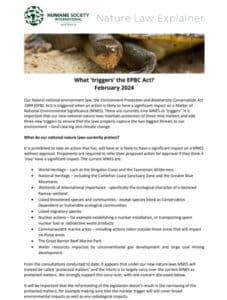One of the most important global meetings on wildlife trade has just wrapped up in Uzbekistan. It’s capital city Samarkand was where governments convened for the 20th Conference of the Parties (CoP20) to the Convention on International Trade in Endangered Species of Wild Fauna and Flora (CITES) to decide how international trade should be managed for some of the world’s most threatened...
Our federal national environment law, the Environment Protection and Biodiversity Conservation Act 1999 (EPBC Act) is triggered when an action is likely to have a significant impact on a Matter of National Environmental Significance (MNES). There are currently nine MNES or ‘triggers’. It is important that our new national nature laws maintain protection of these nine matters and add three new triggers to ensure that the laws properly capture the two biggest threats to our environment – land clearing and climate change.
What do our national nature laws currently protect?
It is prohibited to take an action that has, will have or is likely to have a significant impact on a MNES without approval. Proponents are required to refer their proposed action for approval if they think it ‘may’ have a significant impact. The current MNES are:
- World Heritage – such as the Ningaloo Coast and the Tasmanian Wilderness
- National Heritage – including the Cuttlefish Coast Sanctuary Zone and the Greater Blue Mountains
- Wetlands of international importance – specifically the ecological character of a declared Ramsar wetland
- Listed threatened species and communities – except species listed as Conservation Dependent or Vulnerable ecological communities
- Listed migratory species
- Nuclear actions – for example establishing a nuclear installation, or transporting spent nuclear fuel or radioactive waste products
- Commonwealth marine areas – including actions taken outside those areas that will impact on those areas
- The Great Barrier Reef Marine Park
- Water resources impacted by unconventional gas development and large coal mining development.
From the consultations conducted to date, it appears that under our new nature laws MNES will instead be called ‘protected matters’ and the intent is to largely carry over the current MNES as protected matters. We strongly support this carry over, with one concern discussed below.
It will be important that the reformatting of the legislation doesn’t result in the narrowing of the protected matters, for example making sure that the nuclear trigger will still cover broad environmental impacts as well as any radiological impacts.
It’s also important that our news laws maintain the requirement to seek approval for an action if that action may have a significant impact, opposed to having to know upfront whether it will have a significant impact.
What else needs to be protected under our new laws?
Ecological communities listed as Vulnerable to extinction under our national environmental laws are not treated as a ‘trigger’. This makes Vulnerable communities particularly susceptible to ongoing decline from cumulative impacts, or ‘death by a thousand cuts’. This must be changed in our new laws and Vulnerable ecological communities should become a ‘protected matter’. Conservation Dependent species are managed slightly differently – read our Explainer on how to improve their management.
A key problem with the consultation materials we have seen for new nature laws is the absence of a meaningful integration of climate change. As one of the key threats to our natural environment and wildlife, climate change must be fully integrated into our nature laws. This must involve inserting a climate trigger into the laws. That would ensure that the climate impacts of a project are accounted for when assessing whether an approval should be granted. For example, projects over a certain emissions threshold (for example 100,000 tonnes of lifetime carbon dioxide emissions) should be captured by the laws.
Our current laws also fail to properly assess large scale land clearing. This failing could also be addressed by introducing a new land clearing trigger – one that requires that proposed clearing over a certain threshold in likely threatened species habitat must be assessed under the legislation.
What else needs to change?
HSI Australia has been attending the current stakeholder consultations on the EPBC Act. The material provided to us so far has showed that Extinct species would no longer be listed as a ‘protected matter’. In our view, this is problematic because if a species or community thought to be Extinct was rediscovered during a development application but the Government wasn’t aware of that fact until after an application had been made, there would be nothing requiring consideration of that species or communities under the law. Extinct species should be maintained as a ‘protected matter’ under the new laws.
What’s next?
It was disappointing to see that a Senate Committee report has recommended against the Environment Protection and Biodiversity Conservation Amendment (Climate Trigger) Bill 2022, which would have introduced a climate trigger. We will continue to use the current law reform process to advocate for these important changes to the matters that ‘trigger’ our national nature laws.
Download a PDF version of this blog, so you can print and share with your Member of Parliament.

Learn more about what we need to achieve stronger laws for Australian nature. Read our other Nature Law Explainer blogs:
- What are National Environmental Standards and why do we need them?
- The importance of an “EPA”
- Critical habitat needs protection
- Managing wildlife trade
- Objects and Duties
- Strengthening Conservation Planning
- Climate change
- Community Rights in Decision Making
- Protecting Marine and Migratory Species
- Regional Planning
- What are biodiversity offsets? (Part 1)
- What are biodiversity offsets? (Part 2)
- Strong nature laws shouldn’t be undermined by exemptions
- Environmental assessments and decision-making


